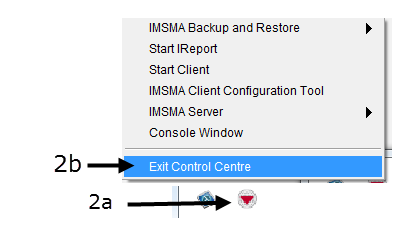Difference between revisions of "Starting and Stopping IMSMANG"
From IMSMA Wiki
m |
|||
| Line 30: | Line 30: | ||
{{note|You may read more about application layers and configuration [[Understanding Configuration Options | here]].}} | {{note|You may read more about application layers and configuration [[Understanding Configuration Options | here]].}} | ||
| + | ==Steps==__NOEDITSECTION__ | ||
For both stand-alone and client/server installations the steps to start and stop are identical. To start follow these steps: | For both stand-alone and client/server installations the steps to start and stop are identical. To start follow these steps: | ||
#[[Display the IMSMA Control Centre Icon|Display the IMSMA Control Centre Icon]] | #[[Display the IMSMA Control Centre Icon|Display the IMSMA Control Centre Icon]] | ||
| Line 42: | Line 43: | ||
[[Image:saS07.png]] | [[Image:saS07.png]] | ||
| + | ==Other TrayLauncher functions== | ||
Other functions in the TrayLauncher menu: | Other functions in the TrayLauncher menu: | ||
* [[Backup and Restore]] | * [[Backup and Restore]] | ||
Revision as of 09:48, 15 February 2015
Contents |
| How To |
|---|
IMSMANG is an application that consists of two layers; client and server, and may be configured in two different ways:
- stand-alone - both server and client parts are on the same computer (incl. database)
- client/server - server and client(s) parts are on different computers but in the same network
|
Stand-alone configuration |
Client/server configuration |
| |
You may read more about application layers and configuration here. |
Steps
For both stand-alone and client/server installations the steps to start and stop are identical. To start follow these steps:
To stop follow these steps:
- Log out of IMSMA
- Stop the IMSMA Server
- Right-click the IMSMA Control Centre and choose Exit Control Centre.
Other TrayLauncher functions
Other functions in the TrayLauncher menu:
- Backup and Restore
- Start iReport
- IMSMA Client Configuration Tool
- Here it is explained how System name is used


